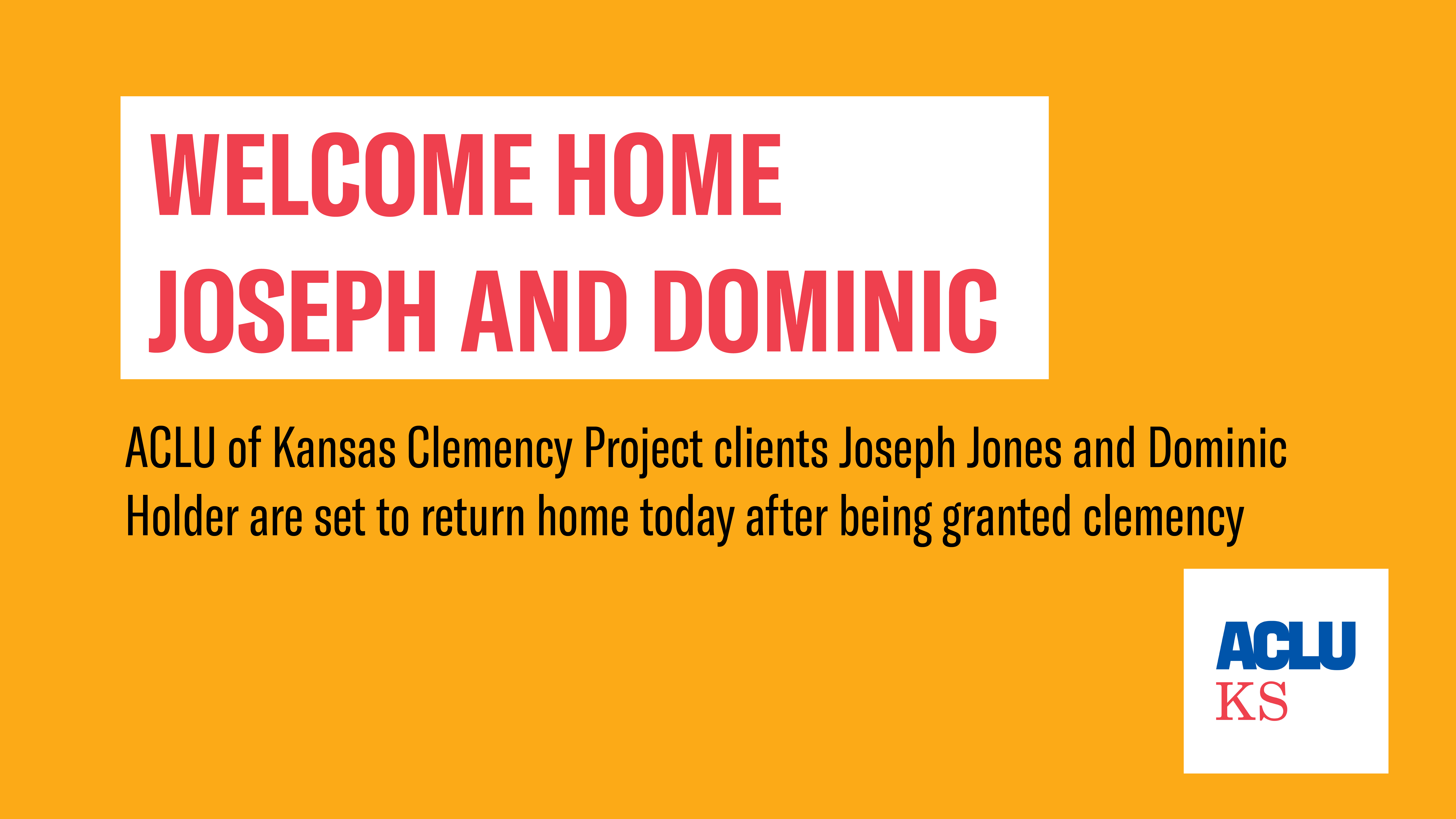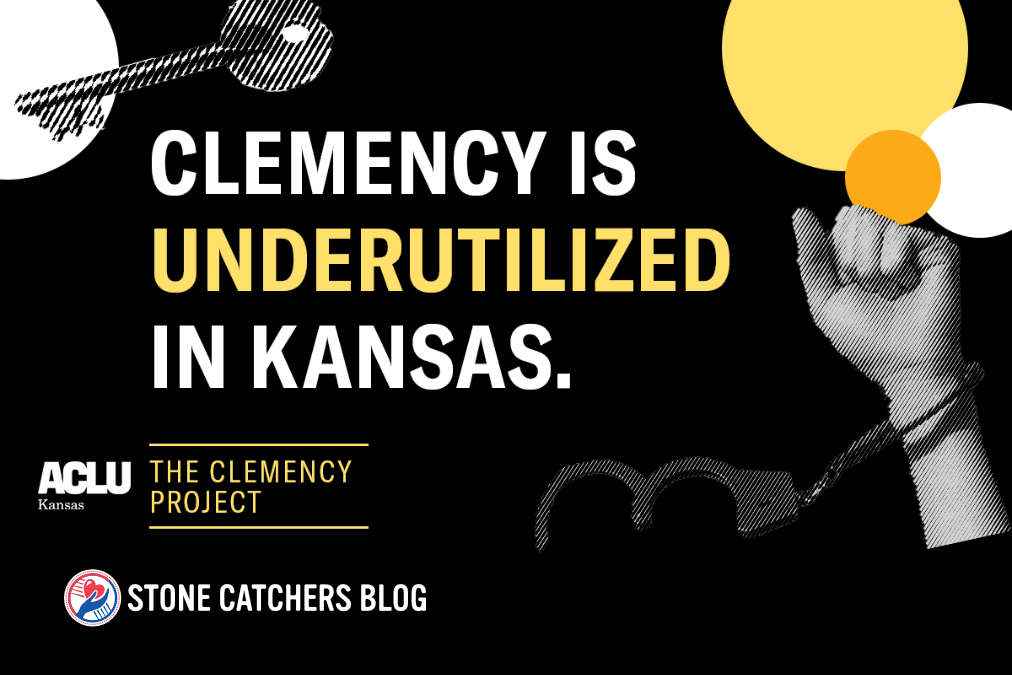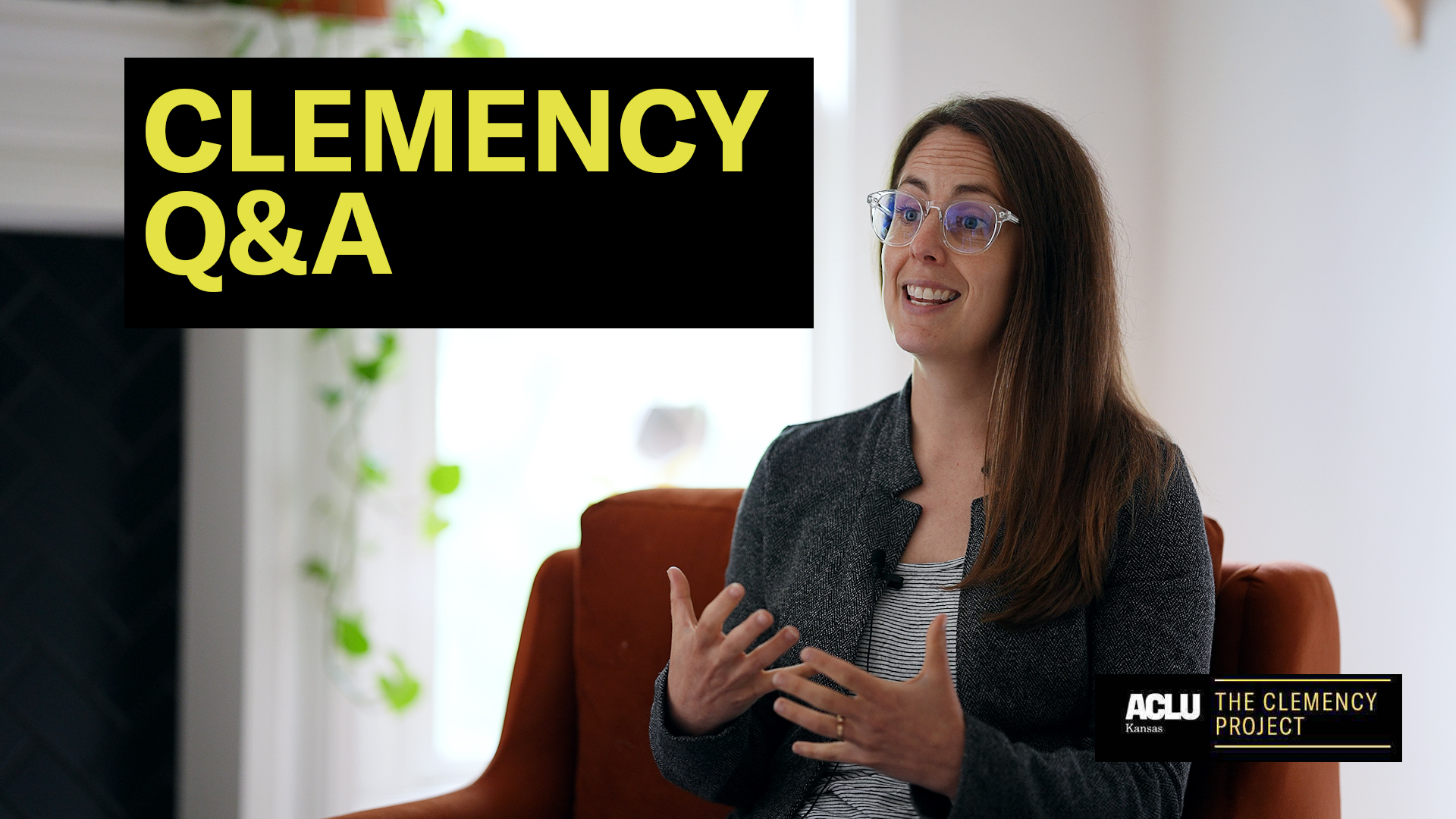Home. Many of us take it for granted, particularly during the worldwide pandemic as ‘working from home,’ morphed into ‘living at work.’ However, as two of our Clemency Project clients, Joseph Jones and Dominic Holder, are released from prison after being granted clemency, they know better than the rest how important home really is.
For each of them, incarceration has meant being far away from home. After being held in Kansas prisons, each can begin the interstate journey back to their families; Jones to Texas and Holder to Indiana.
This joyous homecoming comes at the end of a long process. As COVID rose to a national concern, the ACLU of Kansas legal team began work trying to protect people in crowded prisons. We named this effort the Clemency Project. Our team submitted 108 applications for clemency and created a toolkit that allowed hundreds more to apply themselves. Jones and Holder were among those 108 clients.
As news of our clients’ release broke, the ACLU’s Legal Director Sharon Brett said she could feel the infectious joy from each of them through the zoom screen.
“They wanted to sort of reach through the camera and hug all of us and hug the governor herself,” Brett said then. “It’s a really special thing. It’s giving people the gift of time back with their loved ones.”
While thinking about them, we also remember Christopher McIntyre, our other client who received early prison release as he battled late-stage cancer in multiple parts of his body.
Chris won early release in April via a process for people suffering from medical conditions so severe they no longer pose public safety threats. He died at home, surrounded by family, a measure of mercy extended to him and to his family who feared he’d die alone in his cell.
Joseph and Dominic head home today because state government, at least in part, affirmed our assertion that clemency is not about what you did, but who you are today. It is not about where you’ve been, but what you are going next. It is not about yesterday, but about tomorrow.
Joseph’s mother said of him, “You’re not a felon. You fell off.”
Today demonstrates how clemency transforms lives.
That reminder comes as Joseph and Dominic are once again able to hug their moms, go for walks and enjoy family dinner, now that they’re finally home.
Date
Friday, August 6, 2021 - 1:45pm
Featured image
Show featured image
Hide banner image
Related issues
Criminal Legal Reform
Show related content
Pinned related content
Clemency Q&A with Sharon Brett, Legal Director
Gov. Kelly releases three ACLU of Kansas Clemency Project clients, paving the way for many more such releases
Tweet Text
[node:title]
Type
Menu parent dynamic listing
Show PDF in viewer on page
Style
Standard with sidebar
Show list numbers
Last week, Governor Kelly granted executive clemency to eight Kansans, including three ACLU of Kansas clients. This news came over a year after we started the Clemency Project.
It was a historic action, and supporters note that both the quantity and the timing of these releases were momentous.
But why? Kansas’ clemency powers, like most states, emulate the independent pardoning powers of the US Constitution, which has been the guiding document for our country’s government since 1789.
As we celebrate American Independence this weekend, let’s consider why our Founders deliberately built this tool into our system of government.
A Brief History of Clemency
Clemency is literally built into the foundation of our country: Article II, Section 2 of the US Constitution.
Alexander Hamilton was the one to introduce and support pardoning powers at the Constitutional Convention.
The Framers deliberated on whether Congress should have oversight in the pardoning process— a proposal for Senate approval was the most popular— but ultimately the Founders deemed that the Executive Branch should have exclusive domain over clemency powers.
This was even bigger at the time than we may recognize now. Although the powers of the Presidency have been interpreted more broadly over the years, this was seen as one of the most unilateral executive powers at the time.
Our founders knew how important it was that the executive wield this power away from the judicial and legislative branches. Only then could it serve as the important check and balance it was created to serve.
Clemency through the years
Clemency’s use runs through our entire history; George Washington became the first president to use the power in 1795, further establishing that use of this power was meant to be a norm.
Abraham Lincoln famously granted pardons to encourage Confederate Army soldiers to flip. Then, as Congress tried to amend stipulations around these pardons, the Supreme Court ruled in U.S. v. Klein that they had infringed on this executive power. This further cemented the importance of executive clemency in our system.
Clemency has historically been an often-used power in U.S. history; per the Department of Justice, from 1900 to 2017 there were 22,485 clemency actions granted. That’s an average of over 192 uses of clemency per year granted by US Presidents.
Clemency in Kansas
Similar to the Presidency, the Kansas governor receives pardoning power from the Kansas Constitution (Article I, Section 7), and the process is governed by K.S.A. § 22-3701.
Despite clearly emulating the federal process, clemency isn’t receiving nearly the same level of usage in Kansas.
This is, in part, why Gov. Kelly’s action was so significant. Kansas’ past four governors used this power only 9 times, and, prior to Kelly’s releases, it had been used only a dozen times since 1993.
The other notable factor in these releases is timing; Kansas governors often waited until the end of their tenure to grant pardons, while Kelly did so in the middle of her first term.
A look around
Clemency use in Kansas doesn’t just pale in comparison to the federal government, it also falls short of our neighboring states.
In a four-year period, Kansas received only 84 clemency applications, averaging 21 a year. This is dwarfed by Oklahoma, where they have averaged over 100 applications for the past 15 years.
To our west, Former Colorado Gov. John Hickenlooper issued over 100 pardons; his successor, Gov. Jared Polis, issued a mass pardon to over 2,700 individuals with low-level marijuana offenses.
Even in Missouri, Gov. Mike Parsons issued 36 pardons last month.
The Founder built clemency to be used
While Gov. Kelly’s clemency actions may have been a good start, they cannot be the end. Our federal government and neighboring states both show how this power was meant to be used: frequently.
Clemency is built into our Constitution, both nationally and in Kansas.
George Washington himself paved the way for its continual use as our first president.
So as we celebrate our Founding Fathers and their dedication to life, liberty, and the pursuit of happiness, let’s not forget one of the keys they designed for these ideals: the power of clemency.
Date
Saturday, July 3, 2021 - 5:45pm
Featured image
Show featured image
Hide banner image
Override default banner image
Related issues
Criminal Legal Reform
Show related content
Pinned related content
Clemency Q&A with Sharon Brett, Legal Director
The Clemency Project: Stomach, and now, liposarcoma cancer
The Clemency Project: "His continued incarceration raises more questions than his imprisonment ever answered."
Tweet Text
[node:title]
Type
Menu parent dynamic listing
Show PDF in viewer on page
Style
Standard with sidebar
Show list numbers
Last year, the ACLU of Kansas launched the Clemency Project, and we’ve filed 108 applications for Clemency with Governor Kelly’s Office.
Sharon Brett, Legal Director at the ACLU of Kansas, answers frequently asked questions about the project.
Q: First off, what is Clemency?
SB: Clemency broadly refers to early release from prison as granted by the Governor. Most people know of the Presidential “pardon” power. In Kansas, the Governor has the power to pardon, which can mean either erasing a person’s conviction from the record or—more often—commuting a person’s sentence, releasing them from prison earlier than scheduled.
Clemency is a core part of the balance of power in our state government. Many states grant the Executive Branch this power as a vital check on the justice system. In Kansas, the Governor’s power to grant clemency comes from statute.
Q: How did the Clemency Project get started?
SB: When the epidemic first broke, we recognized, as many civil rights attorneys and people across the country recognized, that the people incarcerated in our prisons and jails were, essentially, the most vulnerable to COVID-19.
There’s no way to social distance in prison; you’re not given sanitation supplies, you’re not even given masks a lot of the time. So people who are living in our prisons and jails were extremely vulnerable to this airborne disease.
So we filed a piece of litigation, Hadley v. Zmuda, that was attempting to get the state to release a large number of prisoners so we could cut down on the population inside of our state prisons and try to allow for some more distance between people and to reduce the number of people who would potentially be exposed in that setting.
Unfortunately, that case was dismissed on procedural grounds, so the affiliate had to look for an alternative path forward to help these people.
Q: So that became the Clemency Project. What is the Clemency Project?
SB: When the Hadley case was dismissed, the affiliate pivoted from a litigation strategy to a project-based strategy that was basically filing a large volume of petitions on behalf of incarcerated people asking the governor to grant them Clemency.
So that’s what we began in late May of last year. In the past year we have filed 108 petitions on behalf of people asking the governor for Clemency.
For a subset of individuals, we’ve also filed something called “Functional Incapacitation.”
Q: What’s Functional Incapacitation? How is it different from Clemency?
SB: Functional Incapacitation is a separate process, but it’s similar to Clemency. It’s also an early release valve, but it’s a little bit different in terms of who gets to make those decisions and the criteria that’s used to evaluate them.
So, Functional Incapacitation is essentially, as it sounds, identifying individuals who are incapacitated. They are often sick or disabled, and the argument to KDOC is that they don’t pose any “threat to public safety” if they were to be released, by virtue of their condition. It is essentially arguing for mercy, and arguing that there is no need to keep them incarcerated.
The functional incapacitation process works differently from Clemency in that the governor is not the ultimate approving authority. Rather, it’s the Prisoner Review Board, which is a part of the Kansas Department of Corrections.
The Functional Incapacitation process is pretty convoluted. The application goes through probably 7 or 8 different layers of review just within the facility where the applicant is incarcerated… then it goes to the Secretary of the Department of Corrections, then it goes to the Prisoner Review Board.
So you have all these officials reviewing this application before a person could actually be granted release due to functional incapacitation, but there are no standards published anywhere on how those decisions are made.
Despite these roadblocks, we had a big success earlier this year when our client Christopher McIntyre was released from prison through the Functional Incapacitation process. Although we’re glad for this, there are so many others who deserve the same chance. We highlight several examples in our Stone Catcher’s Blog.
Q: Do these tools get used often?
SB: Like Presidential pardons, historically these powers mostly get used at the end of a Governor’s term. Both Brownback and Coyler issued limited pardons, both only at the end of their gubernatorial tenures. I’d argue they were intended to be used more actively, throughout a Governor’s term, as part of the system of checks and balances.
Even though Clemency powers are vested in the Governor, the Prisoner Review Board— which I mentioned while discussing Functional Incapacitation— still gives a recommendation as part of the process. We know from what they’ve shared how few applications they recommend for release.
From the records on their website, between 2015 and 2018 they received 84 applications and only recommended 8 for release, so fewer than 10% get recommendations. Likewise, the Functional Incapacitation review process seems to almost automatically produce non-recommendations for release.
So while these tools do get used, the trend is to use them as a Governor’s last act. The Prisoner Review Board’s review authority wasn’t established so that they could blanket-reject applications, and the Clemency power wasn’t built to sit on the shelf until reelection isn’t a concern. Instead, the process needs to be a whole lot more transparent, objective, and fair. And it should be used more often. We’re all familiar with this process already, we just need to use the system throughout a Governor’s term as intended to help Kansans.
Q: What happens when someone is released through either Clemency or Functional Incapacitation?
SB: Clemency applicants also usually plan to live with a partner or family, such as a parent or sibling, but often describe their vocational skills and discuss their plans to find employment. There are differences in plans; some applicants are older and describe a peaceful retirement with loved ones or beloved pets. Regardless, as a part of the process, there is a plan in place.
I often say that clemency decisions should be about not what you did but who you are. It’s not about where you’ve been but where you’re going. That’s what these applications show—plans for release, for employment, for stability and community and connectedness upon release.
Through this project we have heard countless stories of people in prison who have worked hard to be successful after release. We’ve heard stories of people who are sick, and who seek early release to get proper medical care. Clemency is a real tool, granted to the Governor, to help real people change— or sometimes save— their lives.
Q: How do you apply for Clemency?
There are forms you file with different agencies to apply for Clemency. We have a toolkit on our website with a list of every form, examples, and guidance for filling it out. The toolkit walks you through the process, and includes a packet with all the forms as well.
We hope by making this available and as streamlined as possible, we empower people to use this vital process. We know that a lot of people have actually submitted applications through this toolkit, and we want that to continue. People run for Governor to make a difference, and we want ours to see how much Clemency allows her to do just that for families all across Kansas.
Date
Tuesday, June 15, 2021 - 12:45pm
Featured image
Show featured image
Hide banner image
Override default banner image
Related issues
Criminal Legal Reform
Show related content
Pinned related content
Filing for Clemency in Kansas Toolkits
The Founding Fathers have spoken, and they support Clemency
Tweet Text
[node:title]
Type
Menu parent dynamic listing
Show PDF in viewer on page
Style
Standard with sidebar
Show list numbers
Pages




